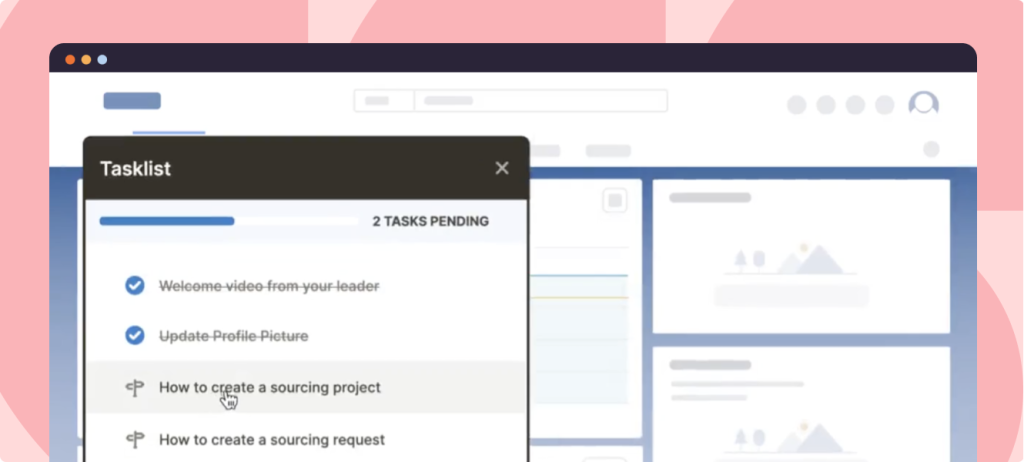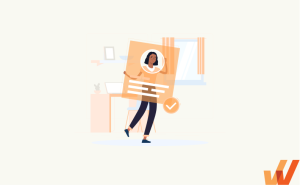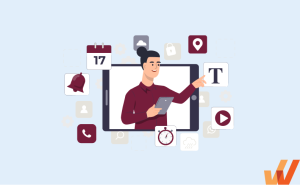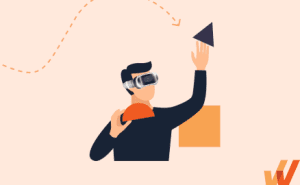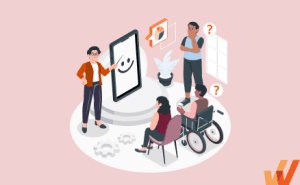In a study conducted by HR Drive, 93% of the workers claimed they wanted easy-to-complete employee training. 91% want personalized training relevant to their position, while 90% want employee training that is also engaging and fun.
For enterprise corporate training teams, the shift towards personalized learning marks a significant evolution in how professional L&D is approached. Gone are the days of one-size-fits-all training programs; today, the focus is on delivering customized learning experiences that cater to the diverse needs, skills, and career aspirations of each employee.
Personalized learning in the corporate environment aligns learning objectives with individual and organizational goals and leverages data analytics to create engaging, effective, and measurable training experiences.
What Is Personalized Learning?
Personalized learning is an approach to learning that involves creating an individualized path for each employee. This plan should be built based on several factors that are unique to each employee, such as existing skills, knowledge gaps, and learning styles.
Personalized learning allows L&D teams to provide learners with educational experiences that work for them so they can absorb information quickly and thoroughly. This contextual approach to learning relies on relevance to build engagement and create more successful workplace learning programs.
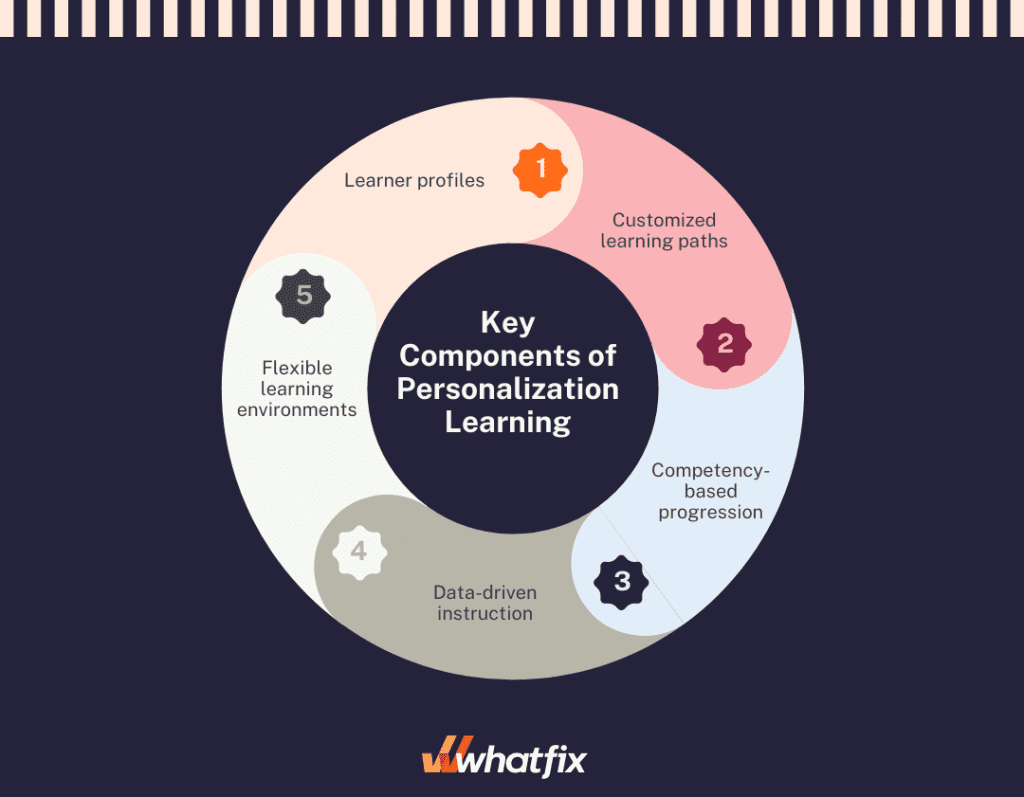
Key Components of Personalization Learning
The nature of personalization means there can be infinite iterations of learning programs, but there are certain key components that are essential to build a foundation for any personalized learning program:
1. Learner profiles
One of the most critical aspects of personalized learning is the creation of individual learner profiles that detail important information about each learner, including their learning background, preferences, goals, and relevant evaluations and assessments. These contain all the information necessary for supporting employees through their learning journeys.
2. Customized learning paths
Individual learning paths are the basis for personalized learning. These paths help L&D teams meet learners where they’re at and provide a personalized roadmap that lays out the learning activities and milestones learners progress through as they work toward their learning goals. Build role-based training programs to accelerate time-to-proficiency for new hires and support organizational outcomes.
3. Competancy-based progression
With personalized learning, the intention shifts from pushing every learner to meet the same checkpoints simultaneously, to individual progression based on competency models.
L&D teams should deliver regular training assessments to determine when individuals have mastered a given task or learning stage and are ready to move on to the next one. This allows learners to move at their own pace and avoid getting overwhelmed by accumulating information before they get a hold of the tasks.
4. Data-driven instruction
Another key aspect of personalized learning is the basis of all instruction on data. Information from screenings, reviews, and learning assessments must be utilized to pinpoint areas that require more or less attention and continue adapting individual learning paths. This approach eliminates guesswork and redundancies that can bog learners down.
5. Flexible learning environments
Flexible learning environments are also critical to personalized learning. Whether learning is happening digitally or in person, employees should be able to engage with educational content in more comfortable, relaxed settings than are typically required for traditional classroom learning. Flexible learning environments reduce distractions and stress, empowering learners to take control over their learning journey.
Related Resources
Benefits of Personalized Learning In the Workplace
Shifting to personalized learning for corporate learning and development leads to stronger, more effective learning experiences overall, helping organizations adapt to changing workforces and stay competitive as the landscape evolves. Here are some of the most critical benefits that personalized learning can bring to a business:
1. Enhanced employee engagement and motivation
By providing employees with the most relevant and personalized training material, L&D teams can fully engage and motivate team members with different learning styles and preferences.
With learning personalization, employees are likelier to feel that the time spent on learning is worthwhile and continue to engage with learning content as they progress. Contextual learning improves learner engagement by connecting training to their day-to-day jobs and tasks, helping them learn more effectively and efficiently and driving further engagement in their work.
2. Improved learning retention
Studies suggest that humans forget 50% of new information within an hour. That increases to an average of 70% within 24 hours. Contextual learning embeds the knowledge within the learner’s natural work flows, enabling better learning retention and helping overcome the forgetting curve.
By delivering lessons that build on existing knowledge and mastery of topics and skills, personalization helps employees retain more of what they’re learning and carry what they’ve gained into their everyday work. L&D teams also leverage new trends like microlearning to enable employees to use bite-sized training modules to help build learning retention over time.
PRO TIP
With Whatfix DAP, enable employees with contextual, role-based learning experiences that overlay their digital workplace and support them in the flow of work. Use Tours and Task Lists to onboard new employees and accelerate time to proficiency. Drive adoption of custom enterprise workflows and support employees on infrequently done tasks with Flows. Smart Tips provide additional context and timely information and nudge users to take specific actions. Self Help provides employees an in-app resource center that integrates with your knowledge repositories, SOPs, and training resources.

3. Increased training ROI
Personalized learning ensures that employees learn more efficiently by providing them with learning content that is appropriate for their needs at a given time and skipping past topics they already know. Focusing on areas that need the most attention and providing regular learning checks reduces the need to return to old lessons and keeps employees moving forward on their journey to mastery.
4. More relevant training
Ultimately, the customization inherent to personalized learning allows L&D teams to design training activities that are truly relevant to the wants and needs of employees’ current responsibilities and ultimate career goals. Adapting lessons to the needs of learners leads employees to feel more supported at work and engaged by the content they’re interacting with, setting them up for future success within the organization.
8 Best Practices for Personalized Training
Incorporating personalization into workplace learning is the clear way of the future, but it can be overwhelming to get started. Harness these surefire strategies to stay on track and ensure that your organization sees all the benefits learning personalization has to offer.
1. Assess individual learning needs
Start strong by inventorying learning expectations and needs across teams and in individual roles. Use surveys, assessments, and annual reviews to compare performance to established core competencies and set benchmarks to guide your customized learning paths later. At this point, the goal is to determine what employees already know, where knowledge gaps lie, and which skills are most critical for different employees to acquire.
2. Identify learning needs and preferences
Next, dig into the preferred learning experience from the employees’ perspective. You can also use surveys here to directly ask them about how they learn best. Ask about preferred modalities, learning styles, and past experiences with workplace training to get a handle on each employee’s situation. Data from previous L&D initiatives are also helpful here.
3. Set specific learning goals
Another important step is to set SMART goals to help set achievable employee learning objectives and track progress. These goals must align with the organizational goals to ensure everybody is moving toward an expected end.
Any employee training needs to have long—and short-term measurable outcomes to evaluate effectiveness. Training objectives help you understand and measure the value training brings to your organization.
As a first step, identify employee training objectives that define the outcomes learners are expected to achieve at the end of the training. Then, figure out how contextual learning can be used to accomplish each of these goals.
Work with key stakeholders like department heads and managers to coordinate goals and maximize training outcomes across the board.
4. Develop customized learning paths for different roles
Personalizing learning journeys is a large undertaking, made simpler by starting with role-based paths that can be further customized down the line with different checkpoints, modalities, and other options that make room for individual preferences. Design baseline learning paths for different roles that incorporate established core competencies and departmental needs to keep team members working toward common goals.
5. Leverage technology
Use a digital learning solution like a learning management system (LMS) or digital adoption platform (DAP) to lighten the L&D team’s workload and enable learners with the personalization and versatility they need to excel. By leveraging technology and learning software, L&D teams can automate most processes associated with gathering data and customizing learning paths to keep corporate learning efforts running smoothly.
- Learning Management Systems: Comprehensive platforms designed to manage, deliver, and track online learning. They enable personalized learning by allowing instructors to create customized learning paths for different learners or groups, based on their skill levels, job roles, and learning objectives. LMS platforms can adapt content and assessments to meet the learner’s pace and performance, offering a more tailored learning experience. They provide analytics and reporting tools that help educators monitor progress, identify areas where learners are struggling, and adjust the curriculum accordingly. Through features such as forums, chats, and peer assessments, LMS platforms also support social learning aspects, further personalizing the learning experience by leveraging the community.
- Digital Adoption Platform (DAP): A DAP specializes in facilitating real-time, f learning directly within software applications. Whatfix enhances personalized learning by offering contextual, in-app guidance through interactive walkthroughs, pop-up tips, and self-help menus that appear just when the learner needs them, within the flow of their work. This approach helps to immediately apply what is learned in practice, ensuring knowledge retention and reducing the learning curve for new software or processes. Whatfix can dynamically adapt its guidance based on the user’s role, actions, and proficiency, making the learning experience highly personalized.
6. Encourage hands-on and experiential learning
In addition to digital learning, give employees opportunities to engage in hands-on and experiential learning. Coordinate with managers and across teams to set up learning experiences that allow learners to bring their learning offline and hone their skills IRL. This might involve collaboration with team members, practicing different skills, or trying new tasks in different real-world situations. Combining all these different types of learning keeps employees engaged and helps improve knowledge retention.
PRO TIP
With Whatfix Mirror, quickly create replica sandbox environments of your enterprise software and web applications. Provide hands-on training to employees without risking live software usage. Build guided experiences like Tours, Flows, and Task Lists to accelerate onboarding.

7. Provide on-demand performance support
Even with the most robust personalized learning programs, employees can still get caught up and need support from managers or IT teams. As employees advance along their learning paths, managers should check their progress regularly and work with them to resolve issues. This goes a long way toward keeping employees engaged and maintaining a positive employee experience in the long run.
PRO TIP
With Whatfix Self Help, provide contextual support to your employees in the flow of work without leaving your enterprise applications. Self Help integrates with your knowledge repositories, process documentation, and LMS, aggregating answers to common application, process, and workflow-related questions. Employees can search for any contextual issue, and Self Help uses Gen-AI to provide conversational answers or prompts in-app experiences to guide users through a task.

9. Use assessments to measure effectiveness
The best way to measure the success of your contextual learning programs is through authentic assessments, where learners must show their command of what they learned by applying that knowledge and skills to real-world tasks. Assessing the outcomes of contextual learning activities will ensure that the transfer of learning has occurred successfully and that employees are well-equipped to use the knowledge learned effectively.
9. Gather feedback and adjust training
As employees embark upon their personalized learning journeys, L&D teams and managers must regularly assess the effectiveness of corporate learning initiatives. Review learning performance data and solicit post-training feedback to adjust goals and learning paths as necessary and improve the structure of the learning programs in response to the needs of employees and the larger organization.
Examples of Personalized Learning
To better understand how to personalize learning experiences and training programs, here are four examples to inspire you:
1. REG uses in-app guidance to accelerate CRM and ERP proficiency for new employees
With over 1,200 employees, REG faced employee onboarding challenges like long time-to-proficiency periods for its Salesforce CRM and JD Edwards ERP, two mission-critical applications that REG relies on for day-to-day operations and to achieve business outcomes.
With no standard, enterprise-wide training process, tribal knowledge emerged, with people trained in various ways to use the same application. REG’s growth compounded the problem: the moment new training content was launched, new undocumented application features often superseded it.
The result was reduced productivity and potential accounting errors. In the case of the JD Edwards accounting platform, it could take up to six months to train a new hire. Accounting errors were commonplace as people inadvertently misused the systems – an issue that could potentially compromise compliance.
REG partnered with Whatfix to provide contextual in-app guidance and on-demand support in the flow of work. With Whatfix, REG enabled new employees with role-based, interactive guidance that drove learning retention with hands-on training. For example, simple step-by-step instructions within the application (called ‘Flows’) are used extensively to help users understand an objective or complete a task through a series of actions. REG can break down complex JD Edwards, Salesforce, and other application journeys into intuitive steps.
With Whatfix, REG’s L&D team achieved a 50% reduction in time-to-proficiency on its CRM and ERP, helping employees get up to speed three months faster than traditional training approaches.
2. Adaptive learning software
Adaptive learning software uses AI to personalize different aspects of a learning experience to tailor training and lesson plans for individual learners. Adaptive learning technology uses learner profiles and preferences to personalize the experience before a learner interacts with a lesson. It then further adapts based on user inputs, such as if a learner incorrectly answers a question, replays a video, skips ahead in a lesson, etc.
3. One-on-one coaching and tutoring
While one-to-one tutoring may sound outdated, it’s still one of the most effective ways of providing personalized, tailored learning and training. Instructors and trainers can communicate directly with learners, understand where they’re facing difficulties, and build lessons that connect with them on a personal level.
Let’s consider an example of 1-1 tutoring in the workplace:
Consider Alex, a new account executive who needs be trained on how to use his company’s CRM. His training begins with a one-on-one session to understand his current skills and career goals. The trainer designs a customized plan that focuses on improving his CRM skills for account management and sales forecasting. The sessions include hands-on projects relevant to Alex’s daily tasks, such as merging duplicate opportunities and creating sales forecasting reports. Regular feedback and adjustments ensure the training aligns with Alex’s progress and the company’s evolving needs. This approach enhances Alex’s efficiency and boosts his confidence in tackling complex CRM challenges.
4. AI-powered LMS
Many corporate LMS providers now use AI to identify skills gaps and concepts employees struggle with. With these insights, the LMS can adapt future lessons and training programs to tailor them to specific employees.
Let’s consider an AI-powered LMS creating personalized training experiences:
Colorado-based helicopter medical transportation company Air Methods used Amplifire LMS to train their pilots. IT used AI to identify learning modules that pilots were struggling with or spending a long time completing, as well as through pilot feedback after they finished their training lessons. With this information, course materials and training programs for each pilot were adapted based on how they answered questions or interacted with learning modules. This enabled Air Methods to cut pilot onboarding in half, from 10 days to 5 days.
Training Clicks Better With Whatfix
Whatfix is a digital adoption platform that lies on top of all your enterprise applications and software to provide personalized in-app guidance to your employees. With robust personalization features like smart segmentation and intelligent self-serve support, Whatfix is an effective tool for upskilling employees to eliminate technology skill gaps through custom-tailored, in-the-moment guidance to help them make the most of any enterprise application.
To learn more about Whatfix training, schedule a free demo with us today!
